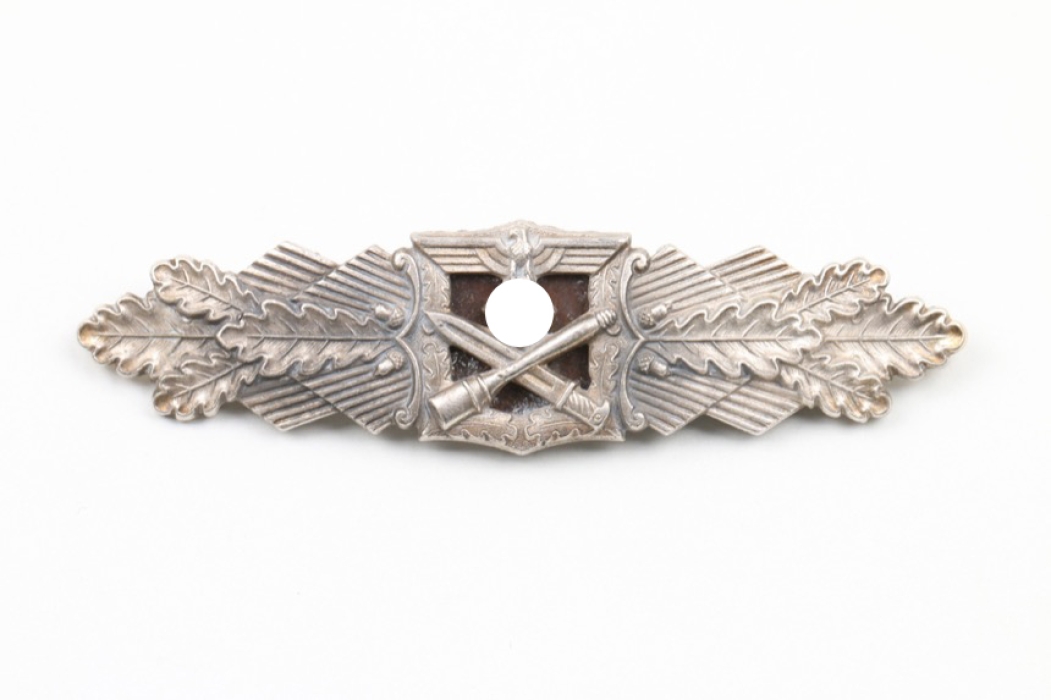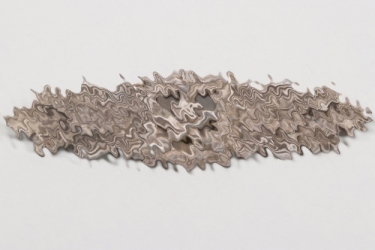Close Combat Clasp 2nd Grade
Buy treasures for a reduced Buyer‘s Premium

Close Combat Clasp in silver
MILITARIA PRICE GUIDE
How can I see prices?
Welcome to the ratisbon's MILITARIA PRICE GUIDE!
To access all prices, pictures, and descriptions please subscribe to our MILITARIA PRICE GUIDE at www.ratisbons.com/militaria-price-guide. Save 25% when subscribing for one year! Get full access for just 75€!
We are buying single items and entire collections! Call +49 8541 9053699
-
PAYMENT
-
HOW CAN I PAY FOR MY ORDER?
AUCTIONSYou will receive an e-mail confirming your successful bids the day after the auction has ended. In your personal my ratisbon's you will be able to inform us about your most convenient payment method for this order or tell us about an alternative shipping address.
If we don’t hear from you within 24 hours, we will send an invoice choosing the payment and shipping options which we think are the most comfortable ones to you. If you decide to change your shipping or payment method after receiving your invoice, just drop us a line or visit my ratisbon's/ORDERS for any more details.
SHOP ORDERSChoose your payment method when ordering and submit your order. Once your order has been received we will send an invoice including your shipping costs and your payment instructions.
After receiving the invoice, the order must be paid within 7 days.
Please contact us to discuss layaway options.To learn more about paying at ratisbon's, please see your FAQ pages.
WE ACCEPT FOLLOWING PAYMENT METHODS
-
-
Versand
-
HOW DO YOU SHIP MY NEW TREASURES?
PACKING & TRACKINGWe usually send out orders within 1-3 working days after your payment has been received. In most cases, we are faster than this! We will inform you when your goods are being dispatched and provide a tracking number, In addition, you can always check your order status at my ratisbon's/ORDERS. Delivery times will vary depending upon the delivery destination and type of shipping service you have chosen.
SHIPPING TO ALTERNATIVE ADDRESSIf you prefer to have your order shipped to your work address or a friend during your absence, we will happy to arrange this for you. Send us an email letting us know about your new shipping address and we will be happy to send an updated invoice to you.
OUR LOGISTIC PARTNERS ARE AS FOLLOWS
-
-
OUR GUARANTEE
-
 OUR GUARANTEE!
OUR GUARANTEE!We only offer collectables which to the best of our specialists knowledge are authentic. About 15% of all consignments are returned to the consignor after extensive research due to authenticity issues.
Unlike traditional auction houses we do offer a full right of return. If you are not satisfied with what you won or bought, you may return it within 14 days. Please inform us and we will instruct you on how to return the goods. For more information, please visit FAQ pages.
Important note: Cancelling bids after an auction may disappoint the consignor, who like you is a collector. This situation is easy to avoid. We encourage you not to bid on any collectable if you are unsure if it fits into your collection. Ask us to cancel your bid 24 hours prior to the end of an auction to avoid this situation.
-
COUNTRY Deutschland
DIMENSIONS
WEIGHT
EAN 2000000143090
PERIOD
COUNTRY Deutschland
COUNTRY Deutschland
LOT K-1807
Description
Condition
See description
NAME
Close Combat Clasp (Nahkampfspange)
DATE OF INSTITUTION
November 25th, 1942. At the height of the battle for Stalingrad, this new award was instituted for front-line soldiers engaged in combat close enough to see the “whites of the enemy’s eyes”, using close combat weapons to assault the enemy in hand-to-hand combat and be victorious.
AWARD CRITERIA
The Close Combat Clasp was awarded to soldiers after they obtained the necessary combat “days”, making it a separate and unique award compared with existing badges like the Infantry or Panzer Assault Badge which kept track of single engagements. The clasp could be awarded to officers, non-commissioned officers, and enlisted men alike once the prescribed number of combat “days” were obtained and confirmed. The counting of combat days started on December 1st, 1942.
GRADES
Grade I = Bronze Class awarded after 15 days of close combat Grade II = Silver Class awarded after 30 days of close combat Grade III = Gold Class awarded after 50 days of close combat
Wounded Soldiers
For severely wounded soldiers who had no further opportunity to complete the necessary combat days, the Close Combat Clasp could be awarded at the discretion of the Division Commander using the following reduced rate:
Grade I = Bronze Class awarded after 10 days of close combat Grade II = Silver Class awarded after 20 days of close combat Grade III = Gold Class awarded after 40 days of close combat
Retroactive Combat Days
The counting of combat days officially started on December 1st, 1942, however special consideration was made for the beleaguered soldiers fighting in Russia on the Eastern Front. Soldiers that had served continuously in Russian since the beginning of the invasion on June 22nd, 1941 would be given credit for close combat days at the following rate:
8 months of deployment = 5 close combat days
12 months of deployment = 10 close combat days
15 months of deployment = 15 close combat days
On March 29th, 1943 the retroactive counting of combat days was extended to soldiers fighting in North Africa since June 22nd, 1941 as well.
PRESENTATION
The Close Combat Clasp was to be worn 1 centimeter above the left breast pocket, or 1 cm above the ribbon bar if one was worn. This is a prestigious location on the uniform, high and above all other combat and qualification badges with the exception of perhaps the Knights Cross of the Iron Cross worn around the neck.
The recipient would receive an official award document; the earliest documents were typically in the DIN A4 format (8” x 12”) or later and more commonly in the DIN A5 format (6” x 8”).
Clasps typically arrived from the manufacturer in simple cardboard cartons, or paper packets and were either handed to or pinned on the soldier by the Division Commander.
Being a mid-to-late war combat award established in late 1942 almost all original Close Combat Clasps were manufactured in Zinc, the material of choice during this period of the war. Only 2 exceptions are known; a very rare clasp made from lightweight Aluminum by the Gebrüder Wegerhoff firm of Lüdenscheid (GWL) and a special Presentation Close Combat Clasp in Gold made from brass/tombak by the renowned C.E. Juncker firm of Berlin.
In mid-1944 Hitler reserved the right to personally hand out the Close Combat Clasp in Gold (III Class) to soldiers at official award ceremonies. A special Presentation Close Combat Clasp in Gold was produced for these ceremonies along with a special presentation case by the Juncker firm. On August 27th, 1944 Hitler presided over the first of 5 group award ceremonies where he would personally bestow a total of 57 Close Combat Clasps in Gold to the recipients. Himmler conducted 2 additional ceremonies where he bestowed a further 99 Gold clasps, with Lt. General Guderian
conducted the last group ceremony, awarding 13 more of the special presentation clasps.
There were at least 12 makers of the Close Combat Clasp, including Juncker who made both regular Zinc-based clasps in all grades as well as the special Presentation Close Combat Clasp in Gold. Most makers made all 3 grades of the Close Combat Clasp and gold-grade clasps were certainly produced in zinc and bestowed to recipients prior to mid-1944 when the special brass/tombak version of the Presentation Close Combat Clasp in Gold was produced.
It is estimated that the Close Combat Clasp was awarded in the following rough numbers:
Bronze = 36,000 Silver = 9,500 Gold = 647
For more information on the Close Combat Clasp, we gladly refer the interested collector to the book “The German Close Combat Clasp of WW2” written by Thomas M. Durante (ISBN: 978-0-9600753-0-0)

















